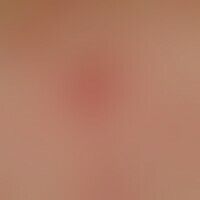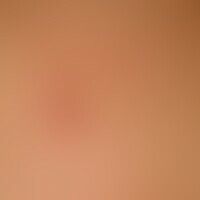Image diagnoses for "Nodules (<1cm)"
392 results with 1369 images
Results forNodules (<1cm)

Insect bites (overview) T14.0
Insect bites: super-infected (pustules in places) insect bites (most likely bug bites).

Malasseziafolliculitis B36.8
Malasseziafolliculitis, detail magnification: In the picture, almost centrally located, a follicle-bound, inflammatory papule, approx. 6 x 4 mm in size, is impressive.

Acuminate condyloma A63.0
Condylomata acuminata. multiple, partly solitary, partly disseminated standing, 0.2-0.7 cm large, macerated papules and plaques with a verrucous surface. the findings shown here are after multiple surgical ablation under currently running local therapy with imiquimod.

Pityriasis rubra pilaris (adult type) L44.0

Fibroma molle (skin tags) D23.-
Soft filiform fibroma: Multiple skin polyps of varying size, brownish red, soft, with a fielded surface.

Lichen planus classic type L43.-
Lichen planus. chronic progressive form (present in this form for about 1 year). plaque-shaped hyperkeratosis in LP palmoplantaris. the flat, yellowish hyperkeratotic plaque is lined by reddish-livid papules. the diagnosis LP is only possible at the roundish papules in the marginal area.

Granuloma anulare perforans L92.02
Granuloma anulare perforans. detail enlargement: solitary or densely standing, skin-coloured to reddish, rough, smooth, peripherally extending, centrally sinking, partly necrotic, non-itching papules on the back of a 40-year-old man.

Komedo L73.8
Comedones and cysts in severe acne comedonica: numerous single (horizontal arrows) and double comedones (vertical arrows). circles: cysts.

Malasseziafolliculitis B36.8
Malasseziafolliculitis:disseminated, follicle-bound, itchy, inflammatory papules and papulopustules on the back of a 34-year-old female patient. skin lesions. no evidence of acne vulgaris. no formation of comedones

Wickham's drawing L43.8
Wickham's drawing: The stripes in each efflorescence appear as broad, white differently configured (also branched) lines; characteristic is the livid discoloration of the lichen planus (dermoscopic picture) .

Acne papulopustulosa L70.9
Acne papulopustulosa: in acne-typical distribution, red-brown papules and papulo-pustules in different stages of development.

Verruca vulgaris B07
Verrucae vulgar. solitary and confluent to a bed, hemispherical, coarse, grayish yellowish papules with a fissured, verrucous surface in the area of the nostrils and on the lower lip in a 10-year-old. The underlying disease is an atopic eczema.

Rosacea papulopustulosa
Rosacea papulopustulosa: disseminated, intermittent papules and pustules that persist for weeks on reddened skin (questionable pretreatment with a glucocorticoid externum); variable feeling of tension of the facial skin.

Pediculosis capitis B85.0
Pediculosis capitis:Numerous nits, recognizable as multiple, pearl-like, white nodules on the hair shaft.

Leprosy lepromatosa A30.50
Leprosy lepromatosa: gradually developing finding with few inflammatory plaques and nodules for many years.

Hirsuties papillaris penis D29.0
Hirsuties papillaris penis: whitish and skin-colored papules on the corona glans penis, angiofibromas are often found in the frenulum area.








